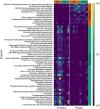The Effects of Probiotic Supplementation on Anthropometric Growth and Gut Microbiota Composition in Patients With Prader-Willi Syndrome: A Randomized Double-Blinded Placebo-Controlled Trial
- PMID: 33681271
- PMCID: PMC7933553
- DOI: 10.3389/fnut.2021.587974
The Effects of Probiotic Supplementation on Anthropometric Growth and Gut Microbiota Composition in Patients With Prader-Willi Syndrome: A Randomized Double-Blinded Placebo-Controlled Trial
Abstract
Background: Prader-Willi Syndrome (PWS) is a rare genetic disorder associated with developmental delay, obesity, and neuropsychiatric comorbidities. Bifidobacterium animalis subsp. lactis has demonstrated anti-obesity and anti-inflammatory effects in previous studies. Aim: To evaluate the effects of Bifidobacterium animalis subsp. lactis probiotics supplementation on anthropometric growth, behavioral symptoms, and gut microbiome composition in patients with PWS. Methods: Ethical Approval was issued by the Internal Review Board (IRB) of the Second Affiliated Hospital of Kunming Medical University (Review-YJ-2016-06). We conducted a 12-week, randomized, double-blind, placebo-controlled trial in 68 patients with Prader-Willi syndrome aged 11 months-16 years (mean = 4.2 years old) who were randomly assigned to receive daily B. lactis-11 probiotics (6 × 1010 CFUs) or a placebo sachet. Weight, height, ASQ-3, ABC, SRS-2, and CGI-I were compared between the two groups at baseline and at 6 and 12 weeks into treatment. Gut microbiome data were analyzed with the QIIME 2 software package, and functional gene analysis was conducted with PICRUSt-2. Results: We found a significant increase in height (mean difference = 2.68 cm, P < 0.05) and improvement in CGI-I (P < 0.05) in the probiotics group compared to the placebo group. No significant change in weight or psychological measures were observed. Probiotic treatment altered the microbiome composition to favor weight loss and gut health and increased the abundance of antioxidant production-related genes. Conclusions: The findings suggest a novel therapeutic potential for Bifidobacterium animalis subsp. lactis probiotics in Prader-Willi syndrome patients, although further investigation is warranted.
Keywords: Bifidobacterium animalis subsp lactis; Prader-Willi syndrome; height; inflammation; microbiome; microbiota (microorganism); obesity; probiotics.
Copyright © 2021 Kong, Wan, Tian, Liu, Liu, Clairmont, Lin, Zhang, Sherman, Zhu, Wang, Fong, Li, Wang, Wang, Liu, Yu, Shen, Cui, Cao, Du and Cao.
Conflict of interest statement
The authors declare that the research was conducted in the absence of any commercial or financial relationships that could be construed as a potential conflict of interest.
Figures









Similar articles
-
Altered Salivary Microbiota Following Bifidobacterium animalis Subsp. Lactis BL-11 Supplementation Are Associated with Anthropometric Growth and Social Behavior Severity in Individuals with Prader-Willi Syndrome.Probiotics Antimicrob Proteins. 2022 Aug;14(4):699-711. doi: 10.1007/s12602-022-09938-0. Epub 2022 Apr 26. Probiotics Antimicrob Proteins. 2022. PMID: 35474569 Free PMC article. Clinical Trial.
-
Targeting the Gut Microbiome in Prader-Willi Syndrome.J Clin Med. 2021 Nov 16;10(22):5328. doi: 10.3390/jcm10225328. J Clin Med. 2021. PMID: 34830610 Free PMC article. Review.
-
The Effects of Limosilactobacillus reuteri LR-99 Supplementation on Body Mass Index, Social Communication, Fine Motor Function, and Gut Microbiome Composition in Individuals with Prader-Willi Syndrome: a Randomized Double-Blinded Placebo-Controlled Trial.Probiotics Antimicrob Proteins. 2021 Dec;13(6):1508-1520. doi: 10.1007/s12602-021-09800-9. Epub 2021 Jun 11. Probiotics Antimicrob Proteins. 2021. PMID: 34115318 Free PMC article. Clinical Trial.
-
Effects of Bifidobacterium animalis Subsp. lactis (BPL1) Supplementation in Children and Adolescents with Prader-Willi Syndrome: A Randomized Crossover Trial.Nutrients. 2020 Oct 13;12(10):3123. doi: 10.3390/nu12103123. Nutrients. 2020. PMID: 33066107 Free PMC article. Clinical Trial.
-
Bifidobacterium animalis subsp. lactis 420 for Metabolic Health: Review of the Research.Nutrients. 2020 Mar 25;12(4):892. doi: 10.3390/nu12040892. Nutrients. 2020. PMID: 32218248 Free PMC article. Review.
Cited by
-
Altered Salivary Microbiota Following Bifidobacterium animalis Subsp. Lactis BL-11 Supplementation Are Associated with Anthropometric Growth and Social Behavior Severity in Individuals with Prader-Willi Syndrome.Probiotics Antimicrob Proteins. 2022 Aug;14(4):699-711. doi: 10.1007/s12602-022-09938-0. Epub 2022 Apr 26. Probiotics Antimicrob Proteins. 2022. PMID: 35474569 Free PMC article. Clinical Trial.
-
The Bifidobacterium-dominated fecal microbiome in dairy calves shapes the characteristic growth phenotype of host.NPJ Biofilms Microbiomes. 2024 Jul 21;10(1):59. doi: 10.1038/s41522-024-00534-4. NPJ Biofilms Microbiomes. 2024. PMID: 39034349 Free PMC article.
-
Targeting the Gut Microbiome in Prader-Willi Syndrome.J Clin Med. 2021 Nov 16;10(22):5328. doi: 10.3390/jcm10225328. J Clin Med. 2021. PMID: 34830610 Free PMC article. Review.
-
Effects of synbiotic supplementation on intestinal microbiota composition in children and adolescents with exogenous obesity: (Probesity-2 trial).Gut Pathog. 2023 Jul 21;15(1):36. doi: 10.1186/s13099-023-00563-y. Gut Pathog. 2023. PMID: 37474971 Free PMC article.
-
The Effects of Limosilactobacillus reuteri LR-99 Supplementation on Body Mass Index, Social Communication, Fine Motor Function, and Gut Microbiome Composition in Individuals with Prader-Willi Syndrome: a Randomized Double-Blinded Placebo-Controlled Trial.Probiotics Antimicrob Proteins. 2021 Dec;13(6):1508-1520. doi: 10.1007/s12602-021-09800-9. Epub 2021 Jun 11. Probiotics Antimicrob Proteins. 2021. PMID: 34115318 Free PMC article. Clinical Trial.
References
-
- Cassidy SB, Forsythe M, Heeger S, Nicholls RD, Schork N, Benn P, et al. Comparison of phenotype between patients with Prader-Willi syndrome due to deletion 15q and uniparental disomy 15. Am J Med Genet. (1997) 68:433–40. 10.1002/(SICI)1096-8628(19970211)68:4<433::AID-AJMG12>3.0.CO;2-T - DOI - PubMed
Publication types
LinkOut - more resources
Full Text Sources
Other Literature Sources

